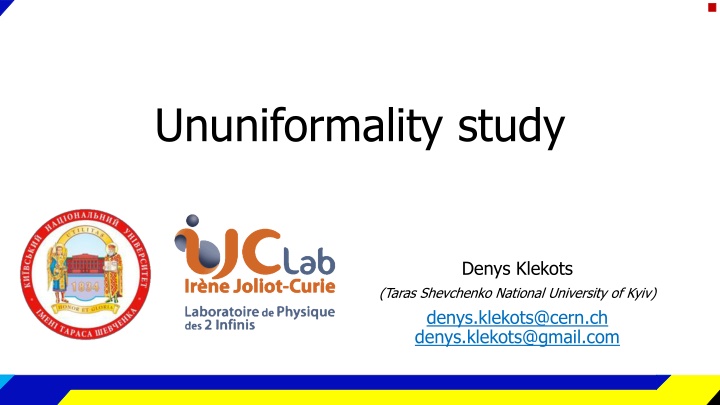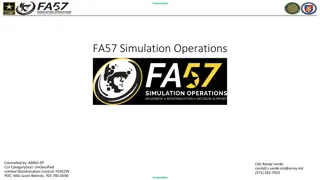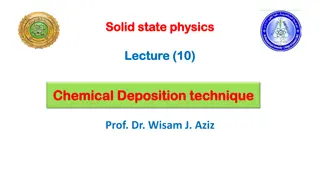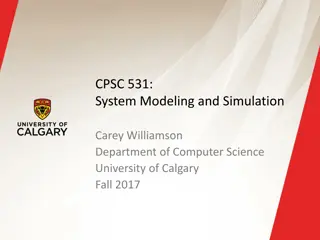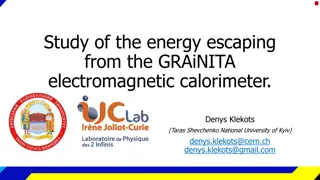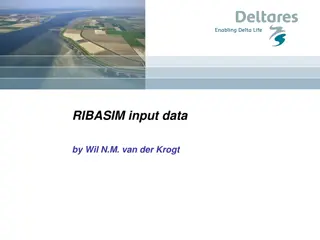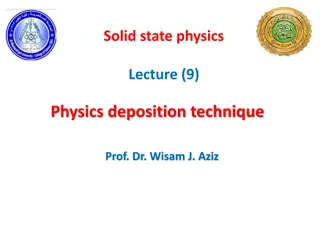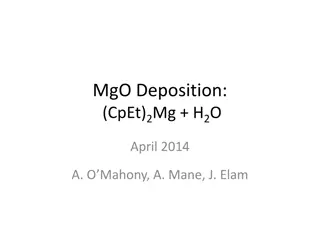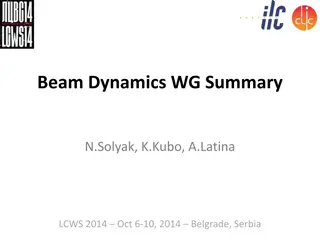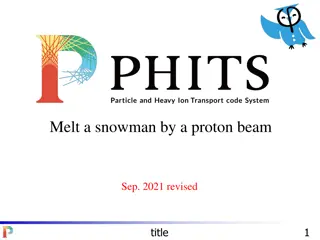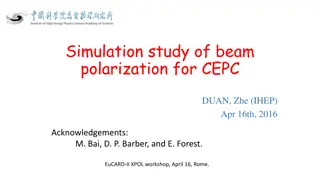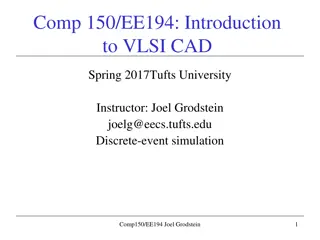Study on Energy Deposition in Ununiformality Simulation by Denys Klekots
Simulation study by Denys Klekots at Taras Shevchenko National University of Kyiv focuses on energy deposition in a detector with non-uniform distribution of primary hits. Results show a linear growth in error on energy measurement with non-uniformity and differences in efficiency maps between 1 GeV and 25 GeV gamma rays.
Download Presentation

Please find below an Image/Link to download the presentation.
The content on the website is provided AS IS for your information and personal use only. It may not be sold, licensed, or shared on other websites without obtaining consent from the author.If you encounter any issues during the download, it is possible that the publisher has removed the file from their server.
You are allowed to download the files provided on this website for personal or commercial use, subject to the condition that they are used lawfully. All files are the property of their respective owners.
The content on the website is provided AS IS for your information and personal use only. It may not be sold, licensed, or shared on other websites without obtaining consent from the author.
E N D
Presentation Transcript
Ununiformality study Denys Klekots (Taras Shevchenko National University of Kyiv) denys.klekots@cern.ch denys.klekots@gmail.com 10.10.2024 Denys Klekots denys.klekots@cern.ch #
Quick recap The simulation gives the energy deposited in a strip for each simulated event. Each strip has the dimensions of 1x1x400 mm. There are 168 by 168 such strips in the detector. WLS fibres are located each 7 mm and the energy deposited in the strip that contains fibre is not recorded in the simulation output. 10.10.2024 Denys Klekots denys.klekots@cern.ch Denys Klekots denys.klekots@cern.ch # 2 10.10.2024
Simulation setup The position of the primary hit was quasi-uniformly distributed in the square between fibers. 7 mm y 7 mm x 2?? 7?? 2?? 7?? Fibers ? = 1 ?cos bcos The energy deposited in each strip was multiplied by the following weight 10.10.2024 Denys Klekots denys.klekots@cern.ch Denys Klekots denys.klekots@cern.ch # 3 10.10.2024
a = b = 7% Measured energy Histograms of event by event measured energy Gamma 25 GeV ? ?= 1,53% ? ?= 1% 10.10.2024 Denys Klekots denys.klekots@cern.ch Denys Klekots denys.klekots@cern.ch # 4 10.10.2024
Dependence of the efficiency on the amplitudes 25 GeV 10.10.2024 Denys Klekots denys.klekots@cern.ch Denys Klekots denys.klekots@cern.ch # 5 10.10.2024
Dependence of the efficiency on the amplitudes 1 GeV 10.10.2024 Denys Klekots denys.klekots@cern.ch Denys Klekots denys.klekots@cern.ch # 6 10.10.2024
Efficiency maps 25 GeV 1 GeV 10.10.2024 Denys Klekots denys.klekots@cern.ch Denys Klekots denys.klekots@cern.ch # 10.10.2024 7
Conclusions The constant term error on energy measurement grows about linearly with the non-uniformity The efficiency maps are very similar /E is worse for 1 GeV gammas compared to 25 GeV 10.10.2024 Denys Klekots denys.klekots@cern.ch Denys Klekots denys.klekots@cern.ch # 8 10.10.2024
Thank you for your attention 10.10.2024 Denys Klekots denys.klekots@cern.ch #
Backup slides 10.10.2024 Denys Klekots denys.klekots@cern.ch #
Resolution: constant term simulation. Quick recap 2 ? The energy accuracy of ECAL is usually parametrized as constant term usually caused by leakage or non uniformity. + ?2. Where y is the ? Simulation is held in the box volume with dimensions 168 x 168 * 400 mm. Volume is simulated as with one material: 4.53 1.19 liquid ? ??3(partial density) of ZnWO4 ? ??3(partial density) of heavy 10.10.2024 Denys Klekots denys.klekots@cern.ch Denys Klekots denys.klekots@cern.ch # 11 10.10.2024
Simulated detector Geant4 simulation was made to calculate the energy detection ununiformality. The simulated primary gamma (25 GeV in this presentation) hit the top face of the detector. The fibers were simulated inside the detector. The distance between fibers is 7 mm. Fibers are cylinders of diameter equal to 1. The detector was virtually split into strips with dimensions of 1 mm by 1 mm by 400 mm. 10.10.2024 Denys Klekots denys.klekots@cern.ch Denys Klekots denys.klekots@cern.ch # 12 10.10.2024
Energy deposition in strips The plot shows energy mean deposition in strips over 1000 events. The energy deposition of strips containing fibers was omitted (as there is no scintillation in fibers). 10.10.2024 Denys Klekots denys.klekots@cern.ch Denys Klekots denys.klekots@cern.ch # 13 10.10.2024
Weights of the strips The energy deposited in each strip was multiplied by the weight. a = b = 7% The weight was estimated from others studied. This approach takes into account that light collection efficiency is different for different strips. 10.10.2024 Denys Klekots denys.klekots@cern.ch Denys Klekots denys.klekots@cern.ch # 14 10.10.2024
Energy deposition histogram. The histogram shows the energy deposited in the calorimeter, after encountering strip weights and excluding energy deposited in fiber strips. The particles were shot nearly randomly in the cube with dimensions 7 by 7 mm. 10.10.2024 Denys Klekots denys.klekots@cern.ch Denys Klekots denys.klekots@cern.ch # 15 10.10.2024
Efficiency map Each bin of the histogram represents the mean (over 1000 events) energy that was deposited if the primary hit was in this specific bin. The histogram is rescaled in such a way that its mean value is equal to 1. 10.10.2024 Denys Klekots denys.klekots@cern.ch Denys Klekots denys.klekots@cern.ch # 16 10.10.2024
Geant4 simulation setup Simulation is held in the box volume with dimensions 168 x 168 * 400 mm. Volume is simulated as with one material: 4.53 1.19 ? ??3(partial density) of ZnWO4 ? ??3(partial density) of heavy liquid Projectile particle energy - deposited energy = escaped energy escaped energy The sum of energy of escaped particles 10.10.2024 Denys Klekots denys.klekots@cern.ch Denys Klekots denys.klekots@cern.ch # 17 10.10.2024
